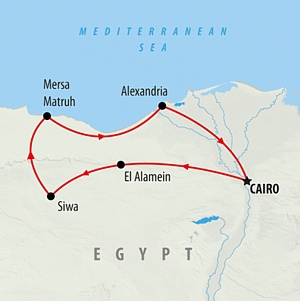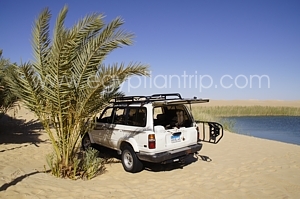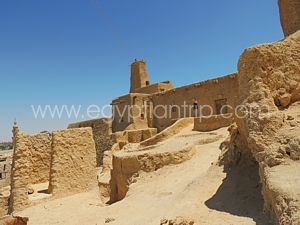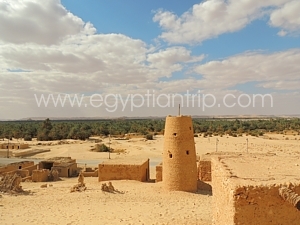Siwa Oasis is an oasis in Egypt, located between the Qattara Depression and the Egyptian Sand Sea in the Libyan Desert, nearly 50 km (30 mi) east of the Libyan border, and 560 km (348 mi) from Cairo.
About 80 km (50 mi) in length and 20 km (12 mi) wide, Siwa Oasis is one of Egypt's most isolated settlements, with 23,000 people, mostly Berber speakers who speak a distinct language of the Berber family known as Siwi. Its fame lies primarily in its ancient role as the home to an oracle of Amon, the ruins of which are a popular tourist attraction which gave the oasis its ancient name Ammonium. Historically, it is part of Ancient Libya. Its modern name Siwa, first attested in the 15th century (earlier Arab geographers termed it Santariyyah), is of uncertain origin. Basset links it to a Berber tribal name swh attested further west in the early Islamic period, while Ilahiane, following Chafik, links it to the Tashelhiyt Berber word asiwan, a type of prey bird, and hence to Amon-Ra, one of whose symbols was the falcon.
Agriculture is the main activity of modern Siwi, particularly the cultivation of dates and olives. Handicrafts like basketry are also of regional importance.The isolation of the oasis caused the development of a unique culture which was shown in its pottery, costume, styles of embroidery and, most notably, in the silver jewellery worn by women to weddings and important occasions. These pieces were decorated with symbols which related to Siwa’s history and beliefs and attitudes. Tourism has in recent decades become a vital source of income. Much attention has been given to creating hotels that use local materials and play on local styles.
An oasis of surprises in a stunning desert landscape.
Siwa, once the most mysterious of all Egypt's oases, is also the most fascinating. It's history has not only been shaped by all major civilizations, but also by the contrast of the surrounding desert with the lush soil of the oasis setting.
The Siwan people have their own culture and customs and, as well as speaking Arabic, we speak own Berber (Amazigh) language. Women still wear traditional costumes and silver jewelers and Siwa remains one of the best places to buy traditional local handicrafts.
The modern town of Siwa is set among thick palm groves, walled gardens and olive orchards, with numerous freshwater springs and salt lakes. Siwa also clusters beneath the impressive remains of the ancient fortress town of Shali.
Come and experience the delights that Siwa has to offer. Climb through the ruins of the old city for magnificent views of the whole oasis. Walk, hire a bicycle or ride in a caretta (donkey cart) to outlying sights and bathing places. Take a dip in one of the many cool and refreshing springs. Taste traditional Siwan foods. Enjoy a truly unforgettable and unique cultural experience.
Another favorite bathing spot for locals and tourists is Fatnas Island, located on the salt lake of Birket Siwa, surrounded by palm trees and beautiful scenery.
Another favorite bathing spot for locals and tourists is Fatnas Island, located on the salt lake of Birket Siwa, surrounded by palm trees and beautiful scenery.
Adventurous travelers will also get their fix of fun and excitement by heading for a safari into the great sand sea or trying out quad biking in the Western Desert of Egypt.
The climate of Siwa
The climate of Siwa is considered to be continental being very cold in the winter and very hot in the summer and moderate in the spring and autumn.
It is advisable to visit Siwa and any other Western Desert destination in the cooler months of the year, from October to April that is when the weather is nice and there are a lot of festivals and celebration in the city. Temperatures in summer can reach up to 35-45 C.
The history of Siwa
According to scientific research dating from the beginning of the last century, Siwa oasis was populated in prehistoric times by people who came from civilisations further west. Their culture and way of life shared much with those of Libya, North Africa and the Nile valley.
Since ancient times, from the Greek to Roman eras and on to the Middle Ages, the oasis was referred to by a variety of names as witnessed by various inscriptions unearthed in temples and on tombs. The more recent name Siwa was derived from the name of the indigenous Ti-Swa tribe.
The ancient oasis of Siwa was crucial to the trade caravans which crossed the desert from the Nile valley in the east to the Mediterranean harbours of Libya in the west. Such was its importance that traders from the southern oases and central Africa were frequent visitors. Siwa also prospered as a religious centre, with many kings sending delegates to consult the Oracle of Amun.
The era of the 26th Dynasty drew to a close with the invasion of a Persian army led by Cambesis - though his 50,000-strong force was later to vanish in a desert sandstorm, leaving no trace behind.
The Oracle of Amun derives much of its fame from Alexander the Great's visit in 331 BC. After consulting the oracle, he claimed to be the son of the god Zeus Amun, and so chose to be buried in Siwa.
Siwa started to go into decline around the sixth century AD, when many of the pagan temples in Siwa fell out of use thanks to the spread of Christianity. This period coincided with the collapse of the Roman Empire and the area's degeneration into anarchy which culminated in the Arabian invasion of Egypt in 640 AD.
|





 |
Alexander the Great in Siwa:
 After Alexander the great conquered Egypt and took control of the county, he started building his amazing city of Alexandria. When he was in process of building his new city, he thought that he wanted to visit the worldwide famous temple of the oracle of Amun which is located near Siwa. After Alexander the great conquered Egypt and took control of the county, he started building his amazing city of Alexandria. When he was in process of building his new city, he thought that he wanted to visit the worldwide famous temple of the oracle of Amun which is located near Siwa.
In 331 AD Alexander the great and some of his companions and army troops left Alexandria and moved in the direction of Marsa Matruh and then to the north in the convoys' way called "Sekket Al Sultan", or the Sultan way. After some days passing by, the water that they had was over and most of the people in the convoy felt horrified. However, on the other day, the sky rained very heavily in this area where it rains very rarely.
However, after a few days, a sand storm from the south took place and Alexander and his convoy lost their way in the desert. Suddenly, two birds appeared in front of them in the desert and Alexander ordered his men to follow these birds saying" these are messengers form Amun.
They factually, afterwards, found their way to the temple of Amun whose priests as well as the inhabitants of Siwa, didn't know that Alexander was visiting, so when they saw him coming, they went to welcome him immediately.
The high priest of the temple of Amun gave the chance to Alexander to go inside the inner room of the temple by himself and consult Amun in his matters and ask him all the questions he had. After Alexander was out of the temple, he seemed happy and satisfied. When his companions asked him about the reason behind his happiness, he said that he will not inform anyone except his mother.
Many historians said that Persian king, Cambyses, wanted to go to Siwa to punish the priests of the temple of Amun because they predicted that his life and achievements will all end painfully in Egypt and the expectations of the priests of Amun turned out to be true after all. When Cambyses took the way going to Siwa, a Sandstorm took place and it destroyed Cambyses and all his army which gave more importance to the temple of the oracle of Amun in Siwa. A lot of history scholar and adventurers dream till today to find any track of Cambyses or his army that consisted of more than fifty thousand men who all disappeared in the Eastern desert of Egypt.
It was said that the most ancient human foot steps were discovered in Siwa in 2007. These footsteps go back to three million years.
The language and the original people of Siwa
The people living in Siwa speak a different language other than the Arabic, or the Egyptian Arabic accent this is because the people in Siwa belong to the Berbers who are the original peoples of North Africa west of the Nile Valley. They are largely distributed from the Atlantic Ocean to the Siwa oasis, and from the Mediterranean to the Niger River.
At the height of Siwa's glory, change was swift and the rewards to victorious assailants were potentially very high. In the eighth century, the Arabian army arrived to conquer Siwa. The inhabitants, an ancient tribe of Amazigh people under Roman rule, were confronted by the Arabian army and given three choices; one, to join the Arabians, two, to pay them tribute and live in peace, or three, to fight for their land.
The clever natives bought themselves time by asking for three days to choose their answer. During this three-day period they gathered together all their riches (such as gold, jewellery, precious stones, and Pharaonic treasures). Then, on the last day, they fled west with all they could carry. Leaving all their heaviest treasures behind, they hid them from the Arabian soldiers and cast spells so that they would be guarded in their absence by the magical powers of their genie.
|
